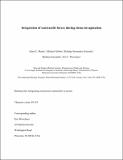| dc.contributor.author | Martin, Adam C. | |
| dc.contributor.author | Gelbart, Michael A. | |
| dc.contributor.author | Fernandez-Gonzalez, Rodrigo | |
| dc.contributor.author | Kaschube, Matthias | |
| dc.contributor.author | Wieschaus, Eric F. | |
| dc.date.accessioned | 2011-10-24T16:25:27Z | |
| dc.date.available | 2011-10-24T16:25:27Z | |
| dc.date.issued | 2010-03 | |
| dc.date.submitted | 2009-10 | |
| dc.identifier.issn | 0021-9525 | |
| dc.identifier.issn | 1540-8140 | |
| dc.identifier.uri | http://hdl.handle.net/1721.1/66553 | |
| dc.description.abstract | Contractile forces generated by the actomyosin cytoskeleton within individual cells collectively generate tissue-level force during epithelial morphogenesis. During Drosophila mesoderm invagination, pulsed actomyosin meshwork contractions and a ratchet-like stabilization of cell shape drive apical constriction. Here, we investigate how contractile forces are integrated across the tissue. Reducing adherens junction (AJ) levels or ablating actomyosin meshworks causes tissue-wide epithelial tears, which release tension that is predominantly oriented along the anterior–posterior (a-p) embryonic axis. Epithelial tears allow cells normally elongated along the a-p axis to constrict isotropically, which suggests that apical constriction generates anisotropic epithelial tension that feeds back to control cell shape. Epithelial tension requires the transcription factor Twist, which stabilizes apical myosin II, promoting the formation of a supracellular actomyosin meshwork in which radial actomyosin fibers are joined end-to-end at spot AJs. Thus, pulsed actomyosin contractions require a supracellular, tensile meshwork to transmit cellular forces to the tissue level during morphogenesis. | en_US |
| dc.description.sponsorship | American Cancer Society (grant PF-06-143-01-DDC) | en_US |
| dc.description.sponsorship | National Institutes of Health (U.S.) (NIH/NIGMS, P50 grant GM071508) | en_US |
| dc.description.sponsorship | National Institutes of Health (U.S.) (NIH/NIGMS, R01 grant GM079340) | en_US |
| dc.description.sponsorship | Eunice Kennedy Shriver National Institute of Child Health and Human Development (U.S.) (grant 5R37HD15587) | en_US |
| dc.description.sponsorship | Howard Hughes Medical Institute (Investigator) | en_US |
| dc.language.iso | en_US | |
| dc.publisher | Rockefeller University Press | en_US |
| dc.relation.isversionof | http://dx.doi.org/10.1083/jcb.200910099 | en_US |
| dc.rights | Creative Commons Attribution-Noncommercial-Share Alike 3.0 | en_US |
| dc.rights.uri | http://creativecommons.org/licenses/by-nc-sa/3.0/ | en_US |
| dc.source | Martin | en_US |
| dc.title | Integration of contractile forces during tissue invagination | en_US |
| dc.type | Article | en_US |
| dc.identifier.citation | Martin, A. C. et al. “Integration of contractile forces during tissue invagination.” The Journal of Cell Biology 188 (2010): 735-749. | en_US |
| dc.contributor.department | Massachusetts Institute of Technology. Department of Biology | |
| dc.contributor.approver | Martin, Adam C. | |
| dc.contributor.mitauthor | Martin, Adam C. | |
| dc.relation.journal | Journal of Cell Biology | en_US |
| dc.eprint.version | Author's final manuscript | en_US |
| dc.type.uri | http://purl.org/eprint/type/JournalArticle | en_US |
| eprint.status | http://purl.org/eprint/status/PeerReviewed | en_US |
| dspace.orderedauthors | Martin, A. C.; Gelbart, M.; Fernandez-Gonzalez, R.; Kaschube, M.; Wieschaus, E. F. | en |
| dc.identifier.orcid | https://orcid.org/0000-0001-8060-2607 | |
| mit.license | OPEN_ACCESS_POLICY | en_US |
| mit.metadata.status | Complete | |
